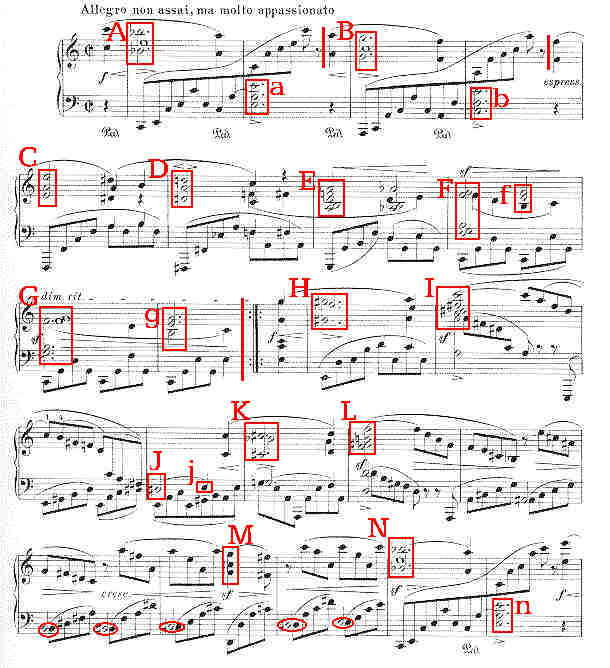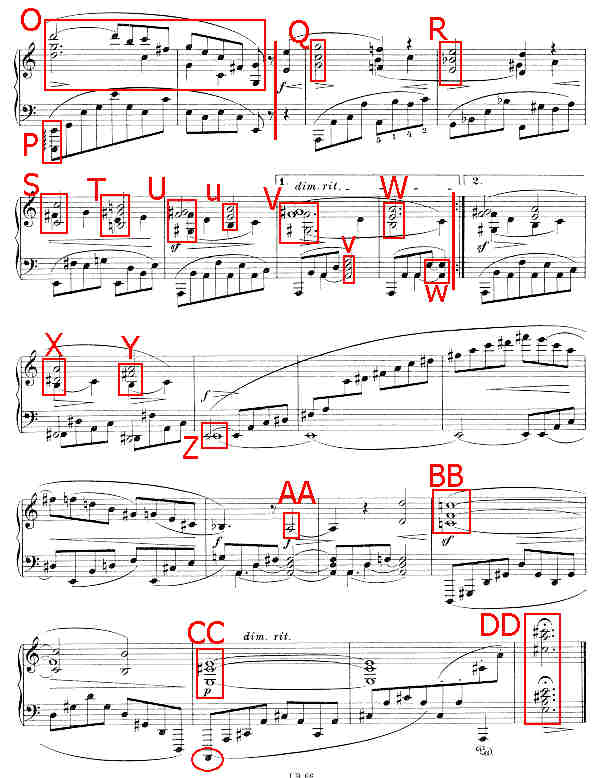

Johannes Brahms
1833-1897
Intermezzo Op. 118 #1
Saturday, October 2, 1999
This short stubby bearded figure walking away from us with a pronounced heel to ground gait, hands clasped firmly behind him, is once again our query. What on earth could he have been up to writing this tiny two page technical monstrosity in which he stretches the common binary form to its emotional breaking point? Is he exuberant, happy, angry, what? We're going to try and find out. Here's the first page.

It doesn't look easy and it isn't. About the only thing easy about it is the key signature. Brahms had enormous mits and one needs big hands to play this one well. It seems like a lot of pianists play it, but very few ever put it into a program. There are all kinds of ways in which the tensions in this piece can get away from you, many opportunities to stumble and end up making many horrible mistakes. The time signature roughly says, "not always fast but always expressive". A lot of pianists like to play this piece as fast as they can, rushing right through it. Believe me the effect on an audience that's never heard it before is that this guy Brahms sure must have had a rough day when he wrote this one, either that or he was some kind of madman.
Well, I like to give this piece another context before I play it; a nature scene, to be exact, an Alpine mountain nature scene. My clues for this are written right in the score; "a" is to "A" and "b" is to "B" as echoes to something shouted. And I do like to "nail" these chords when I play the first measures. But I don't rush it. When I mean "nail" I mean using the whole weight of my upper body to come down squarely on the chords but not pounding them. Again near the end, more echoes; "f" is to "F" and "g" is to "G". The effect of growing softer is to increase distance. Approaching "D", "E" and "F" are leading "nudges" where I like to lean into the left hand notes a bit to support the phrasing, gradually getting softer as I approach the first double bar where I have placed a horizontal red line which means "full stop". If I give it just enough silence, when I repeat the attack the audience is bolted out of their seats as the repeated attack comes as unexpectedly as was the first. A too timid approach to this piece is boring to me and politely suggests that the performer lacks sufficient audacity. The repeat is not obligatory but it really makes little sense not to use it and without it the whole piece seems stunted. It's short enough anyway. This is one of the more declamatory Brahms pieces; he's painting with big broad strokes, shouting and hearing the echoes reverberate off the rocks faces and sheer cliffs of his tonal Alpine setting.
The brilliance of the first eighteen measures; nine measures with a pickup repeated, are followed by the tonally amazing second half, where more sheer drops are suggested by a series of descending arpeggios of diminished chords. These need to be played legato as much as possible with a conscious attempt to make them seem to be falling, not by an acceleration of tempo as much as a slight increase in volume from top to bottom, loudest at the bottom but backing off the attack once you get there. "H" and "I" are suggested shouts like, "Hey Brahms let's go for a walk up here in these mountains" and he or you are thinking that it's a long way down if you lose your footing; "j" is to "J" maybe someone kicked a rock loose and it bumps and crashes its way down making a thud and echo at the bottom. "K" and "L" reiterate the first suggestion and the walk begins in earnest, the footfalls circled lead up past "M", which is a very surprising little place in the piece and needs careful attention to make it come out a bit from the texture surrounding it, and on up to "N" with its echo at "n" and on farther up onto the second page where a tremendous fall of some sort is encountered, maybe a glacial face, depicted in a characteristic Brahmsian phrase outlined in jagged octaves at "O".

I made note of "P" because this is one of those quick, in place rolled octaves that one encounters from time to time in romantic piano literature. It's for emphasis: make it very short and go on with the rest of the phrase. What's going on in "O" above it will require support. If you've made it this far without making any mistakes you're entitled to a "full stop".
The phrasing between "Q" and "W" are really "going down the mountain" from the highest vantage point at "O". Watch your step, especially the left hand which can get a bit tricky but all of it needs accurate articulation. Yes, "v" is to "V" and "w" is to "W"; more echoes.
Now, since this second section is going to be repeated anyway and it's about a walk in the mountains which has already happened, how should it be played, any different from the first way through? Oh yes, try playing it a shade quieter throughout, almost as a mental reflection back over what just happened. The second time through there will not be any break and you go right on through to "Z" where you make a big phrase as if looking back on the glorious mountains with a bit of a yearning ache, a catch in your throat especially at "BB". And at "CC" circled underneath it is your opportunity to use that lowest note on most of our pianos. Don't roll the final chord at "DD", make it a kind, calm, lasting chord. Use the natural weight of your forearms and hold the fermata, releasing the damper pedal before removing your fingers from the keys.
This piece always has me set up for the one immediately following it; a good rest after the exertion of the Alpine walk. But that will have to wait for another day.